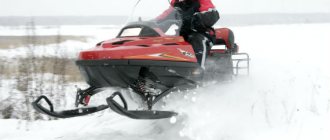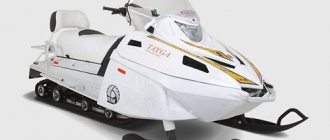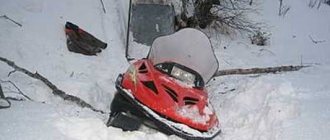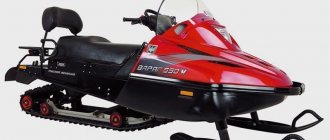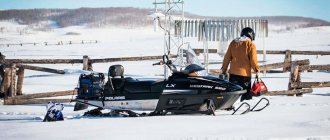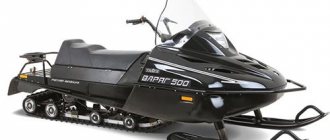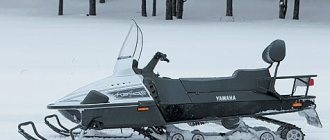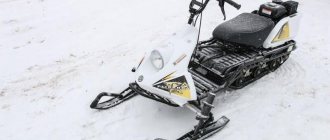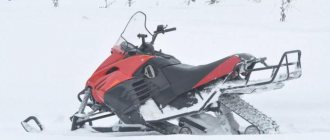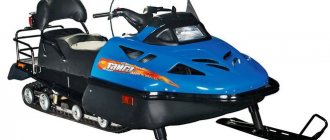Domestic snowmobiles have a special character, focused on practicality and utilitarian operation. Of course, there are exceptions, but harsh conditions and the average level of infrastructure development in the regions themselves set such requirements for the properties of equipment. Nevertheless, ergonomic nuances are never ignored - to the extent possible, they are calculated even in budget versions.
The balance in characteristics, in particular, is confirmed by snowmobiles from Russian Mechanics, a manufacturer from Rybinsk. One of the most successful developments of this company in recent years can be called the modification “Taiga Varyag 550 V”. The device has an optimized technical base, which also causes a number of its disadvantages. However, based on the totality of performance qualities, taking into account the price tag, this option at least deserves attention when choosing a utilitarian snowmobile.
Specifications
In terms of its main parameters, the unit corresponds to the general trend in the class of utilitarian mountain models. Of course, this version is not included in the narrow circle of massive high-power equipment, but the possible lack of performance is compensated by the dynamics of the Taiga Varyag 550 V snowmobile. The technical characteristics of the device are presented below:
- Engine capacity – 2 cylinders of 553 cm3.
- Power potential – 55 liters. With.
- Fuel tank volume – 40 l.
- Suspension travel is 150 mm at the front and 385 mm at the rear.
- The caterpillar dimensions are 397 x 51 x 3.5 cm.
- Overall dimensions – 299 x 105 x 142 cm.
- Track size – 96 cm.
- Speed limit is maximum 80 km/h.
- Number of places – 2.
Thanks to its relatively compact platform and considerable power, the snowmobile provides good dynamics and maneuverability. This is an advantage over large representatives of the mountain utility segment. Compared to younger versions, the Varyag has advantages in the form of high cross-country ability and technical reliability. Although these indicators also have their own conventions, which were noticed during the operation of the device.
Long-range test - long-term test of the Taiga Varyag 500 snowmobile
We were able to carve out a few truly winter days in our failed winter and drove almost a thousand kilometers behind the wheel of our Varyag. As part of the run organized by Russian Mechanics, we walked the path from Rybinsk to Veliky Ustyug
Utilitarian snowmobile/2014/265 kg/503 cm3/43 hp/199,900 rub.
Mileage at the time of publication - 1100 km
We did it! We were able to carve out a few truly winter days in our failed winter and drove almost a thousand kilometers behind the wheel of our Varyag. As part of the race organized by Russian Mechanics, we walked the path from Rybinsk to Veliky Ustyug.
We will tell you about the trip itself, which, it should be noted, is unprecedented in the practice of factory test drives a little later, when photos and video materials are ready, but now let’s talk about how our test subject performed during the run, and in general, what good and bad happened to "Varyag" for the month that has passed since the previous report.
Let's start with the good stuff. At the very beginning of the test, we wrote that we planned to retrofit the snowmobile to the state of a comfortable machine. “Varyag 500” is a basic model, deprived of many “amenities” for the sake of cheaper prices. However, no one forbids “finishing with a file” and “making it to your liking.”
Fortunately, the base of the device is completely identical to the more advanced model “Taiga 550 V”; there was no need to reinvent the wheel. We installed "sports" combs on the driver's footpegs. It seems like a small thing, but how much easier it has become to “live”! The eternal problem of feet slipping during active driving has gone into oblivion! It is clear that all foreign cars, and even more expensive RM models, are equipped with this option in the database, but the “five hundred” did not have them. “Teeth” can be purchased from any dealer; they are installed in a few minutes using a couple of blind rivets.
The second long-awaited acquisition is a passenger backrest. The new model part is attached not to the base of the seat, as before, but to the trunk frame. Since there are already holes in the trunk (the unit is unified with the older model), attaching the backrest with four bolts is not difficult. It's a matter of five minutes. But the passenger immediately gains comfort, safety and tranquility. Now you don’t need to frantically grab onto the pilot so as not to fall “overboard” during acceleration or on potholes. Naturally, the back is equipped with comfortable handles to hold on to. It would be logical to install passenger steps, but for now there is no particular need for them. The passenger already has somewhere to put his feet, but the pilot often gets in the way when he has to move back and forth on the footrests.
It is quite common practice for snowmobilers to ride with a backpack. Thermos, snack, spare gloves or mask. in general, a minimal gentleman's set is always with you. If a passenger appears on a snowmobile, the backpack “moves” onto his back so that it does not interfere between the riders. We used to travel like this, but the “grown” back does not fit well with the backpack. Therefore, we installed a trunk in the trunk.
The case is made of frost-resistant and waterproof material. It fits perfectly into the dimensions of the trunk, since it was created specifically for the Taiga series. The case is attached to the trunk frame with straps, but God protects those who are on the safe side, and just in case, we secured the case with a Hungarian rubber band - a generally accepted practice. The bag has several compartments, is adjustable in volume and holds an incredible amount of junk. Even a portable refrigerator is included. By the way, a very useful option if you are going on a picnic. In it, like in a thermos, sausage, pate, cheese and other products, not to mention liquids, do not turn into pieces of ice that have to be chewed or warmed up by the fire and on the exhaust pipe. In addition, we finally installed a new windshield to replace the one that was broken a month and a half ago. After these simple modifications, the snowmobile turned out to be fully equipped for long trips.
Controls
The snowmobile is provided with a standard set of monitoring and control equipment, including handles, throttle levers, ignition switch, engine mode switches, etc. The main control element is the steering wheel. It is represented by a motorcycle-type device and is designed for the traditional style of directional travel. The left side of the steering wheel is also provided with a brake actuator, which, when released, automatically returns to its original position. It is worth noting the optics control system of the Taiga Varyag 550 V snowmobile. Owner reviews indicate convenient linking of headlight operating modes to the speedometer panel. The user can monitor the current state of the optical configuration through a special indicator. The mechanical handle for switching the lights (from low to high, and vice versa) is located on the remote part of the left steering wheel grip.
Brake system
The mechanism for forcing the snowmobile to stop is based on a hydraulic circuit. As already noted, on the left side of the steering wheel there is a brake cylinder, as well as a container with liquid. Before starting a trip, you should always check the fill level of the tank. It can be controlled through a transparent window, which is located directly in the cylinder wall. At the same time, for the correctness of the indicator, it is important that the Taiga Varyag 550 V snowmobile be maintained in a strictly horizontal position. Owner reviews also note the ergonomic interface of the handle with the parking brake mechanism. There is also a special lever for it on the left side of the steering wheel, but this configuration does not affect the ease of manipulation.
Control devices
One of the key drawbacks, in terms of functionality, is the lack of a tachometer. Competitive models of the same class are provided with similar devices that reflect information about engine overheating, speed data, temperature conditions, etc. And yet it is worth noting the advantages of the speedometer, which is located on the hood of the Taiga Varyag 550 V snowmobile. The description of this device can be presented as follows: a small information panel, which displays information about the current operating parameters, as well as alarms. Of course, the main information is related to the dynamic characteristics, and in particular the speed limit. It was already noted above that the speedometer is also provided with an indicator of the activity of the optics operating mode. The mileage display function, traditional for tachometers, is also included here. You can update information using a special button located on the device.
Model features
To ensure that the reduction of individual operational parameters does not lead to outright compliance with budget modifications, the manufacturer decided to use a number of non-standard solutions. First of all, the front suspension of the Taiga Varyag 550 V snowmobile stands out, which is represented by a telescopic design with a stroke of 150 mm. The basis of the machine is also worthy of attention - the power plant, equipped with two Mikuni system carburetors. Although the RMZ-550 engine itself cannot boast of anything special, the two-channel fuel mixture supply configuration increases its efficiency.
The developers also provided a programmable ignition circuit, with which you can easily control the equipment in different operating modes. In order to improve physical ergonomics, the landing zone of the Taiga Varyag 550 V snowmobile was also optimized. The design features in this part are due to the two-level seat, which has the ability to remove the backrest, and also has handles for the passenger.
Suspension and brakes
Since most of the time the snowmobile moves over rough terrain, it needs a reliable and energy-intensive suspension. The driver and passenger must feel confident in the saddle, covering tens and even hundreds of kilometers.
The developers chose for their brainchild technical solutions that have proven themselves in practice, installing a telescopic fork with a stroke length of 105 mm at the front, and a slick suspension at the rear with a stroke of 190 mm. The vibration energy is absorbed by monotube gas-oil shock absorbers.
By giving the name Varyag to the Taiga snowmobile, its creators seemed to want to emphasize that the car was created to conquer the snow-covered Russian expanses. The chassis copes with this task quite successfully, without causing problems for riders in the saddle.
Hydraulic disc brakes allow you to quickly stop a car accelerated to 80 km/h. But this does not mean that you can rush across snow-covered fields without looking back. Under a thick layer of snow, any surprises can await you. You have to always be on your guard.
User reviews about the model
Practicality has become the main positive aspect of using a snowmobile for many owners. They note design flexibility, ease of operation, ease of maintenance and other qualities quite characteristic of utilitarian technology. The possibilities of regrouping, transforming and replacing individual components deserve special attention. This is not so common in domestic devices. For example, many emphasize the value of the 500 mm wide snowmobile track, which is provided as standard. With such equipment, the equipment can provide stable operation even in harsh conditions that require increased traction. In general, the main delivery set itself deserves a positive review, since, in addition to additional tracks, it also includes lugs and a tow bar.
Maintenance Requirements
The main work involves cleaning the engine. It should be regularly removed from dirt and deposits. The condition of the cylinder-piston group and the quality of tightening of threaded connections are also checked. It is advisable to clean surfaces with hair brushes or scrapers without damaging the plastic consumables. Functional spare parts must have sufficient fastening reliability. The same snowmobile track is installed on the base with the optimal load level for the mounting force. Next, the electrical equipment, connections in the wiring contacts, as well as the operability of the devices are checked.
Repair and service
Also used here was the DUCATI CDI programmable ignition system, which ensures optimal operation of the power unit regardless of operating modes. You can’t immediately give up, saying that the Russian one is not rated for extreme trips for hunting or other recreation, so we visually compared these two ski-tracked vehicles, and it turned out. And what it turned out to be, we’ll find out below.
Pros of a snowmobile
The device turned out to be well-assembled, reliable and functional - these are its main advantages. As for the quality of the element base, there are some complaints about it, but in general, thanks to the widespread use of imported parts, the design is wear-resistant and durable. In terms of the overall configuration, we can talk about the ambiguity of the Taiga Varyag 550 V snowmobile. The pros and cons in this case overlap - for example, reducing the size of the relatively larger representatives of the class made it possible to achieve good maneuverability, but at the same time had a negative impact on the power characteristics.
Engine
The vehicle in question received the only power plant in the engine range, the RMZ-550, which has proven itself to be reliable and unpretentious over long runs. The unit is a two-cylinder, two-stroke design with a working volume of 0.5 liters. The basic version uses a single Mikuni carburetor system, and the optional version has two carburetors. The engine develops a power of 50 horsepower, which is an increase of 5 liters. With. less than the forced version (Limited). Cooling is air type, starting type is electric starter, which can be replaced with a manual starter (if necessary). Thanks to the listed components, the engine has increased reliability; it starts confidently in cold and warm weather. Due to this, it can be argued that there is no need to change the RMZ-550 engine to a more modern one. After all, the proven engine still shows excellent results in terms of reliability and endurance.
Cons of a snowmobile
Still, the model can hardly be considered a full-fledged all-terrain mountain utility vehicle. It can be used in this capacity, but with serious limitations. There are many more attractive solutions on the market, the creation of which focused on power as the main consumer characteristic. In this case, we can talk about the desire to make a hybrid device, which determined the operational limitations for the Taiga Varyag 550 V snowmobile. Reviews from equipment owners, for example, indicate the low effectiveness of the model as an assistant in critical operations during transportation. The same applies to the possibility of providing assistance to equipment stuck in the snow.
Practical reviews on the operation of the Taig snowmobile
You have decided to buy a Taiga snowmobile. But before buying a snowmobile, you still want to ask for opinions from people who already own snowmobiles. We looked through many forums of snowmobile enthusiasts and compiled a list of comments with both positive and negative reviews.
When reading, please note that snowmobile owners do not write phrases in their reviews: “Don’t buy Taiga”, “Buran”, “don’t buy Ski-Doo”. From this follows the conclusion: “to buy or not to buy a snowmobile, any of the manufacturers of snowmobile equipment, everyone decides for himself.
As tasks are presented to the selected snowmobile, the requirements for it during operation increase. So, if for some it is enough to just ride across the field with their family, then for others it is necessary to hunt further in the taiga in difficult terrain or overcome mountainous terrain.
In this article, we will provide reviews from snowmobile owners who have practical experience in operating domestic snowmobiles in different parts of the country, testing their operation in various weather conditions and sharing how “Taiga” and “Buran” cope with the tasks assigned to them.
Leonid, Republic of Mordovia. “The Taiga in the fifth configuration has been in operation for four seasons. Satisfied with almost everything. Fuel consumption is 30-35 liters per hundred kilometers. The cross-country ability is excellent. A small shrub up to 7 centimeters in diameter easily crushes. 30 meters of cable and a winch can easily fit under the seat, and an ax is also there. “Slusa” easily tolerates water with ice and snow.”
Sergey, Novosibirsk. “I decided to go around the stream - I slid onto its side - I stopped - I saw the melted ice and the lack of snow, I thought, “I’m going to go over and I’ll fail.” In principle, that’s what happened. It was in January 2022. I unwound the winch, hooked it to the towbar from behind and behind the poplar tree, fortunately it was a meter away from me, and pulled off at full throttle. "Taiga" has excellent cross-country ability in forested areas, as well as on different terrain. But you definitely need to put a bump stop on the front. The welding of snowmobiles now is not so great.”
Alexander, Arkhangelsk. “My photo clearly shows Taiga’s “landing” (the mass of the snowmobile is concentrated entirely on the skis). In large snowdrifts, the snowmobile sits down with its entire bottom and gets stuck; in order to get it out, you have to crush the snow or even turn it around with your hands and put it on the trail.
But the weight of the “Buran” snowmobile is placed at a decent distance under the caterpillar engine, if you sit down, it’s enough to simply trample the snow, swing it and drive off. I have nothing against double-ski snowmobiles, but my choice was the Buran (I really like to spend the night in a warm place).”
Artem, Moscow region, Domodedovo city. My Taiga has already clocked 3,000 kilometers. I am transporting a snowmobile from Domodedovo to the Rybinsk forests. I'm hunting there with a friend. In the event of a serious malfunction, you will have to leave it there. Only a ranger has a snowmobile there, if you reach it on foot 40-50 kilometers and the equipment is on the move. I made a new mixture (one carburetor, a needle on the bottom on the 2nd groove, plus oil at more than 1:40, at the moment it’s still running. If possible, I put under the seat everything that could be useful for repairs. For minor repairs over several years of operation, I replaced a lot of things. But it’s good, at least not while hunting, but at the dacha (while riding through the fields). I come hunting a couple of times a year. Of course, there’s a desire for a foreigner to take it, but I’m not yet ready to throw away a certain amount of money. The taiga is currently completely satisfied with all its shortcomings.
Alternative proposals from Russian Mechanics
The Rybinsk manufacturer not long ago released a junior version of the model in question called “Varyag 500 V”. Accordingly, the engine size was reduced, as was the power output. This version costs about 50-70 thousand rubles cheaper. It has a separate lubrication system, a simplified suspension and a short transmission stroke. Interesting snowmobiles from Russian Mechanics are also represented in the Bars line.” In particular, modification 850 can be considered, on the contrary, as an older snowmobile relative to the Varyag 500 V. This option is suitable just for those who want to get a real utilitarian snowmobile, and with a hint of touring performance.
Operating values: • Operating parameters
Lubrication system Joint Separate Maximum speed, km h Not less than 80 CHASSIS Transmission CVT RM, low, high, reverse, neutral Braking mechanism Hydraulic or mechanical at customer's request, disk ELECTRICAL EQUIPMENT Starting system Electric and manual Ignition CDI capacitive programmable ignition Electric starter Yes Reverse Yes Heating steering wheel handles and throttle trigger Yes Halogen headlight, 55 60 Speedometer odometer Yes CAPACITY Oil tank capacity, l 2.5 Fuel tank, l 40 SUSPENSION Type lane. Some are confident in its reliability and moderate gasoline consumption, while others are not satisfied with the fact that the lubrication system is not combined with the fuel supply, and therefore they have to prepare the fuel mixture themselves.
